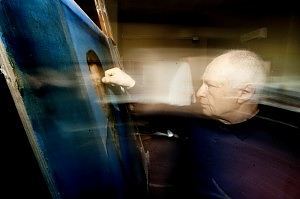Mario Donizetti. The Sweet Obsession 11 Novembre 2012 – Posted in: . ENGLISH TEXT
 The text of Gianluigi Colin published in Mario Donizetti, a biography by Iacopo Di Bugno.
The text of Gianluigi Colin published in Mario Donizetti, a biography by Iacopo Di Bugno.
In his Why Read the Classics?, Italo Calvino amuses himself by defining ‘classic books’: “Books that are referred to as ‘classic’ are ones that constitute a wealth for those who have read and loved them; however they are not a lesser wealth for those who are fortunate enough to have read them for the first time in the best condition to appreciate them”. This is a refined eulogy to mindful reading, or better yet, to ‘mature’ reading, filled with experience. However, we know that this is true for many things: for books, for art, but above all for the various challenges that life forces us to confront. What does this have to do with Mario Donizetti? Is it because Mario is a Classic artist? I would have to say no, because it would be like monumentalizing him before his time. Calvino’s words on the contrary offer an interesting piece of advice to better understand his way of seeing and revealing the world: in a time of infinite discussions about the identity and value of contemporary art, Donizetti appears like a distant antimodern hero anchored to an idea from the past, precisely the Classic period. Is this really true? An artist’s function is to relate his own period in time. To be witness to the narration of the present. It is for this reason that every artist from every period creates art that is, in a certain way, contemporary. What struck me most about Mario Donizetti was not just the power and precision of his brushstrokes, his sensual bodies painted with the vital energy and expressive strength of a great Master of the past, but rather his being anchored to an idea of the present which has the value of memory as its foundation. After all, playing with paradoxes, Mario Donizetti is a conceptual artist who transformed memory into a formal, technical, stylistic but above all spiritual exercise.
Those who have met Mario Donizetti and his wife Costanza know this well. As do those who have visited his small studio in Bergamo’s old Upper Town and have studied the pictorial tech- niques which Mario has dedicated himself to with an almost maniacal attention: egg-yolk tempera, the invention of an encaustic painting method, the creation of “encaustic pastel work” and other experiments and research. But above all, those who recognize the relationship that Mario has with the transmission of his multifaceted knowledge (from philosophy to theology, from pedagogy to music) and the great battle that he and Costanza fight in defence of the artistic heritage, condemning the butchery of art in our tormented land, know it well. In his own very personal way, Donizetti is close to realty. Not only because his paintings represent one of the highest ex- amples of figurative painting and realism, but for his being, without many nuances and with peremptory tones, a ‘total’ intellectual: from his philosophical studies – “I talked about theology with the Pope” – to the invention of a new way of writing music, from his experience as a designer, to his intense essay-writing. His vision also compels him to create paintings filled with symbolism in keeping with the contradictions of our society. An example? Take a look at the series The Seven Deadly Sins or the painting She Wanted to Know: it depicts a crucified woman, a metaphor of the tormented and unfortunately current female condition.
There is, in the end, a dimension of Mario Donizetti that reveals his most visible yet most hidden and intimate identity; that of the artist in relation to his source of inspiration, his wife Costanza. During my first meeting with her, I felt the same emotion that I would have experienced had I been able to undertake an impossible voyage in time, exchanging glances with Caravaggio’s model who posed for his Madonna of Loreto, or with the beautiful young woman painted by Pollaiolo who is now the modern testimonial of the Poldi Pezzoli Museum in Milan.
It was symbolically a meeting with the Muse. In reality, in that moment, I had simply met the woman who had always accompanied Mario and has always been his accomplice, travel companion, jointly responsible of a common destiny and guardian angel of every moment in his life. I do not believe it possible to discuss Donizetti’s art without emphasizing the relationship of absolute devotion between the artist and his model.
I enjoyed observing Mario explain his precious pencil drawings that were almost all of his wife, and listening to the undertone of Costanza’s comments as she recalled each drawing’s moment and meaning. An affectionate game that hides an indissoluble bond, a sweet obsession that communicates the most simple yet profound being of an artist: possessing art as life and life as art.
